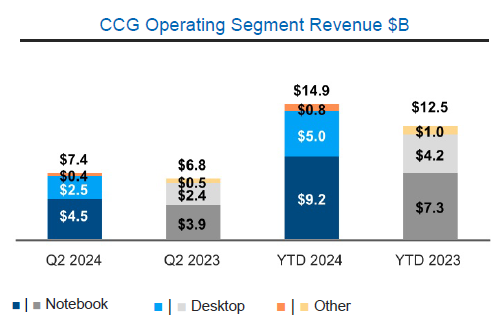Intel’s initial quarterly reporting made it clear that in the client segment, the company’s revenue grew 9% year-over-year to $7.4 billion, but the report on Form 10-Q made it possible to better understand the structure of the changes. As it turned out, supply volumes of Intel components for desktop PCs and laptops increased by 11%, but the average selling price in the first case decreased by 4%, and in the second increased by 4%.

Image source: Intel
Actually, in the laptop components segment, Intel’s revenue in the second quarter increased year-on-year by 15% to $4.5 billion. In fact, Intel received more than 60% of its revenue in the client segment from the sale of laptop components. The desktop segment accounted for approximately 34% of the company’s customer division revenue in the second quarter, with the remaining 5% attributed to other components.
In the desktop segment, Intel’s revenue in the last quarter increased by 4.2% to $2.5 billion. As in the case of the mobile segment, in physical terms, the number of delivered desktop components increased by 11% year-on-year, but the average selling price fell by 4%. As the manufacturer notes, this happened mainly due to the high concentration of products of previous generations in the structure of the desktop components sold. The company is still dealing with the effects of warehouse overstocking caused by the pandemic, although the situation is improving.

In the mobile segment, the concentration of processors from previous generations also harmed the company, but in this case this factor was outweighed by both the supply of new products manufactured using Intel 4 technology and the lower concentration of models with fewer cores, which are objectively cheaper. The average selling price of Intel mobile components in the second quarter increased by 4% year-on-year.
If we consider the interval from the beginning of the year, then in the first half of the year, supply volumes of Intel components for laptops increased by 24%, and the average selling price increased by 2%. In the desktop segment, shipment volumes increased by 19% as customers more actively cleared their warehouses of old products in the previous months, but the average selling price remained at the level of the first half of 2023.